Effective Communication and Negotiation Skills: A Detailed Report
VerifiedAdded on 2023/01/10
|8
|1777
|63
Report
AI Summary
This report delves into the crucial aspects of communication and negotiation skills, examining challenges and proposing solutions for effective workplace interactions. The analysis encompasses various communication barriers, including cultural, language, age, emotional, and non-verbal challenges, and suggests strategies like SOPs for employee hygiene and orientation, along with tailored communication methods. A significant portion of the report focuses on the 1981 Air Traffic Controllers Strike, evaluating the use of ethical negotiation tactics, assessing the government's response, identifying the party at fault in the negotiation breakdown, and proposing alternative strategies for both PATCO and the government. The report concludes with a comprehensive review of the case study, emphasizing the importance of fair negotiation, conflict resolution, and effective leadership in managing complex situations.
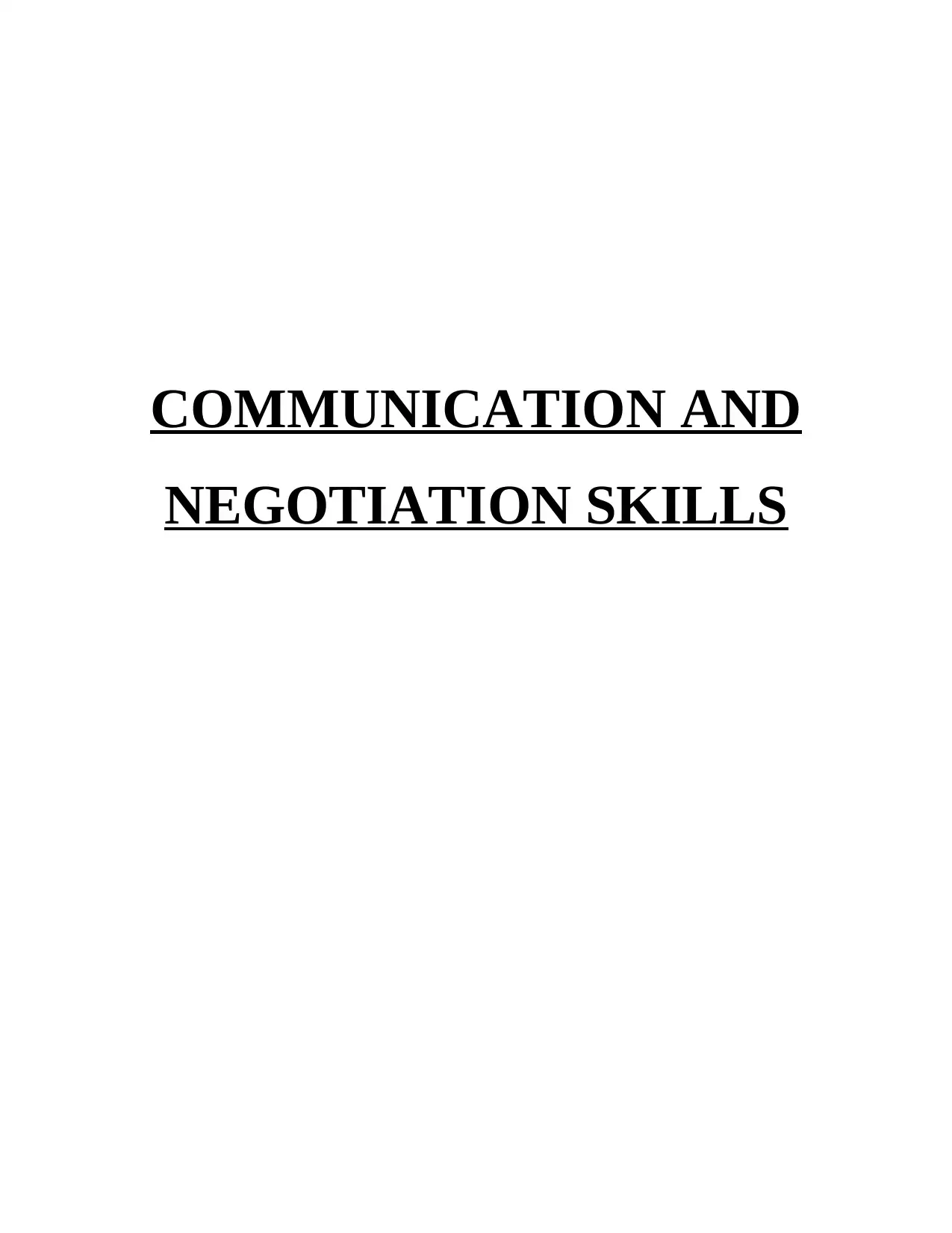
COMMUNICATION AND
NEGOTIATION SKILLS
NEGOTIATION SKILLS
Paraphrase This Document
Need a fresh take? Get an instant paraphrase of this document with our AI Paraphraser
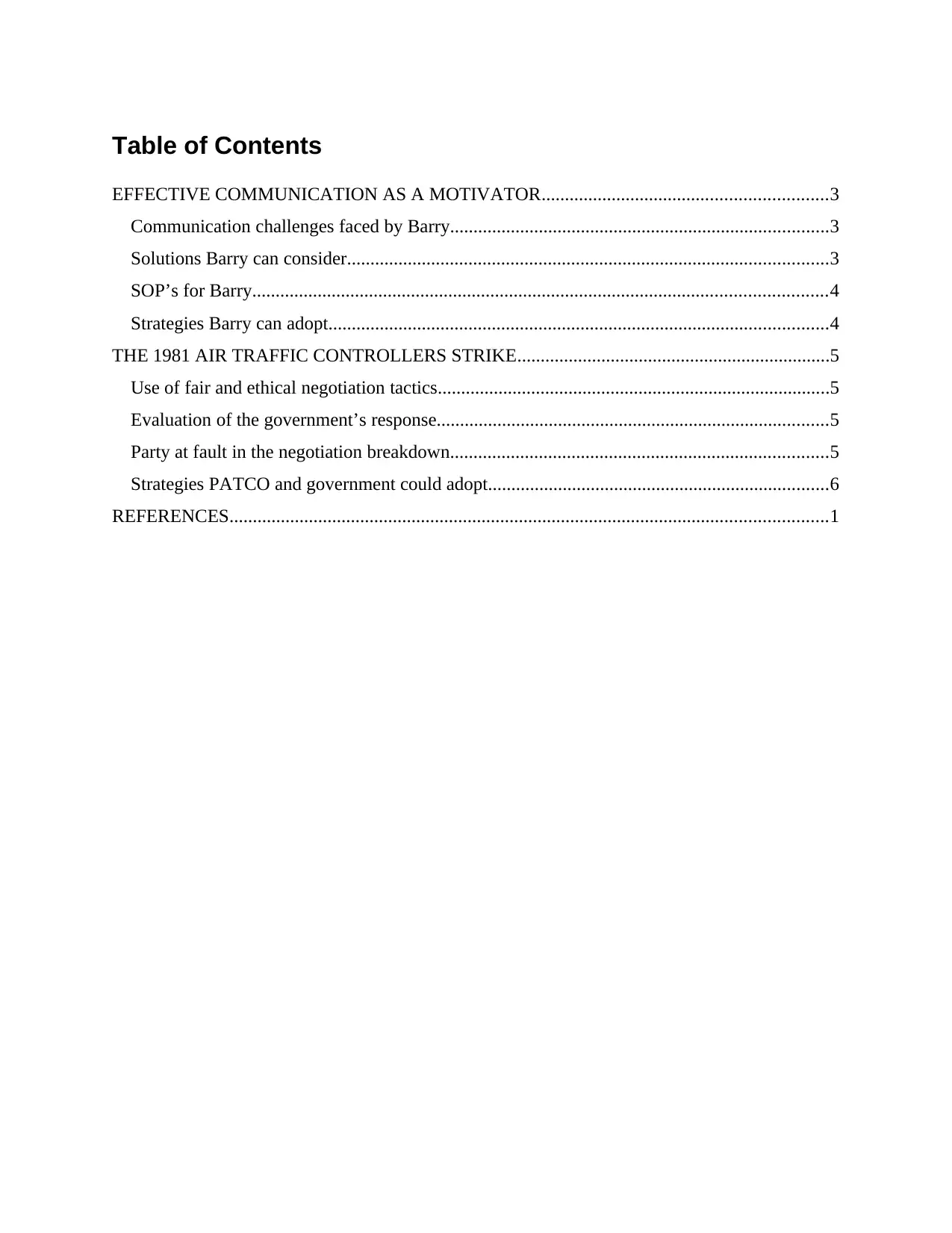
Table of Contents
EFFECTIVE COMMUNICATION AS A MOTIVATOR.............................................................3
Communication challenges faced by Barry.................................................................................3
Solutions Barry can consider.......................................................................................................3
SOP’s for Barry...........................................................................................................................4
Strategies Barry can adopt...........................................................................................................4
THE 1981 AIR TRAFFIC CONTROLLERS STRIKE...................................................................5
Use of fair and ethical negotiation tactics....................................................................................5
Evaluation of the government’s response....................................................................................5
Party at fault in the negotiation breakdown.................................................................................5
Strategies PATCO and government could adopt.........................................................................6
REFERENCES................................................................................................................................1
EFFECTIVE COMMUNICATION AS A MOTIVATOR.............................................................3
Communication challenges faced by Barry.................................................................................3
Solutions Barry can consider.......................................................................................................3
SOP’s for Barry...........................................................................................................................4
Strategies Barry can adopt...........................................................................................................4
THE 1981 AIR TRAFFIC CONTROLLERS STRIKE...................................................................5
Use of fair and ethical negotiation tactics....................................................................................5
Evaluation of the government’s response....................................................................................5
Party at fault in the negotiation breakdown.................................................................................5
Strategies PATCO and government could adopt.........................................................................6
REFERENCES................................................................................................................................1
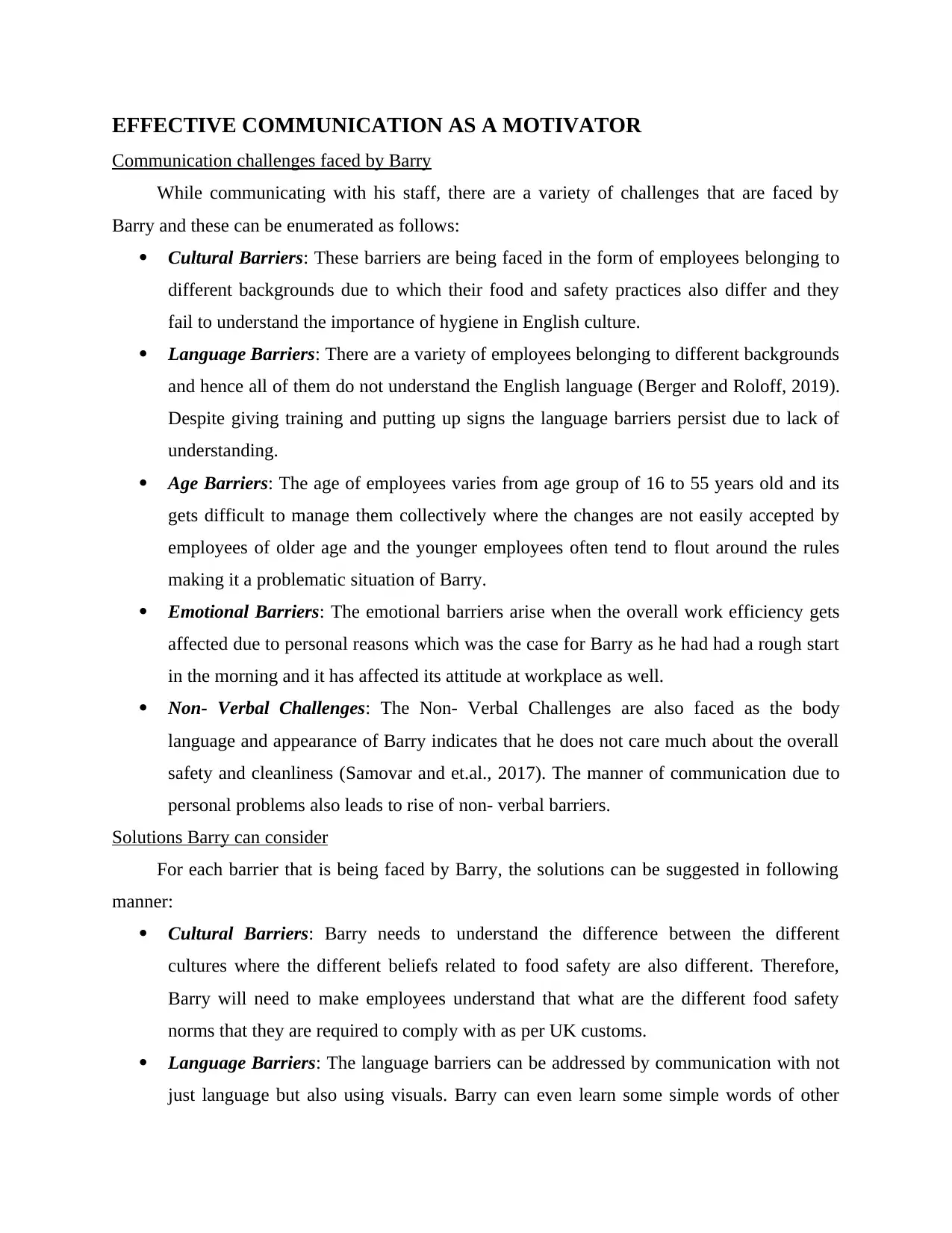
EFFECTIVE COMMUNICATION AS A MOTIVATOR
Communication challenges faced by Barry
While communicating with his staff, there are a variety of challenges that are faced by
Barry and these can be enumerated as follows:
Cultural Barriers: These barriers are being faced in the form of employees belonging to
different backgrounds due to which their food and safety practices also differ and they
fail to understand the importance of hygiene in English culture.
Language Barriers: There are a variety of employees belonging to different backgrounds
and hence all of them do not understand the English language (Berger and Roloff, 2019).
Despite giving training and putting up signs the language barriers persist due to lack of
understanding.
Age Barriers: The age of employees varies from age group of 16 to 55 years old and its
gets difficult to manage them collectively where the changes are not easily accepted by
employees of older age and the younger employees often tend to flout around the rules
making it a problematic situation of Barry.
Emotional Barriers: The emotional barriers arise when the overall work efficiency gets
affected due to personal reasons which was the case for Barry as he had had a rough start
in the morning and it has affected its attitude at workplace as well.
Non- Verbal Challenges: The Non- Verbal Challenges are also faced as the body
language and appearance of Barry indicates that he does not care much about the overall
safety and cleanliness (Samovar and et.al., 2017). The manner of communication due to
personal problems also leads to rise of non- verbal barriers.
Solutions Barry can consider
For each barrier that is being faced by Barry, the solutions can be suggested in following
manner:
Cultural Barriers: Barry needs to understand the difference between the different
cultures where the different beliefs related to food safety are also different. Therefore,
Barry will need to make employees understand that what are the different food safety
norms that they are required to comply with as per UK customs.
Language Barriers: The language barriers can be addressed by communication with not
just language but also using visuals. Barry can even learn some simple words of other
Communication challenges faced by Barry
While communicating with his staff, there are a variety of challenges that are faced by
Barry and these can be enumerated as follows:
Cultural Barriers: These barriers are being faced in the form of employees belonging to
different backgrounds due to which their food and safety practices also differ and they
fail to understand the importance of hygiene in English culture.
Language Barriers: There are a variety of employees belonging to different backgrounds
and hence all of them do not understand the English language (Berger and Roloff, 2019).
Despite giving training and putting up signs the language barriers persist due to lack of
understanding.
Age Barriers: The age of employees varies from age group of 16 to 55 years old and its
gets difficult to manage them collectively where the changes are not easily accepted by
employees of older age and the younger employees often tend to flout around the rules
making it a problematic situation of Barry.
Emotional Barriers: The emotional barriers arise when the overall work efficiency gets
affected due to personal reasons which was the case for Barry as he had had a rough start
in the morning and it has affected its attitude at workplace as well.
Non- Verbal Challenges: The Non- Verbal Challenges are also faced as the body
language and appearance of Barry indicates that he does not care much about the overall
safety and cleanliness (Samovar and et.al., 2017). The manner of communication due to
personal problems also leads to rise of non- verbal barriers.
Solutions Barry can consider
For each barrier that is being faced by Barry, the solutions can be suggested in following
manner:
Cultural Barriers: Barry needs to understand the difference between the different
cultures where the different beliefs related to food safety are also different. Therefore,
Barry will need to make employees understand that what are the different food safety
norms that they are required to comply with as per UK customs.
Language Barriers: The language barriers can be addressed by communication with not
just language but also using visuals. Barry can even learn some simple words of other
⊘ This is a preview!⊘
Do you want full access?
Subscribe today to unlock all pages.

Trusted by 1+ million students worldwide
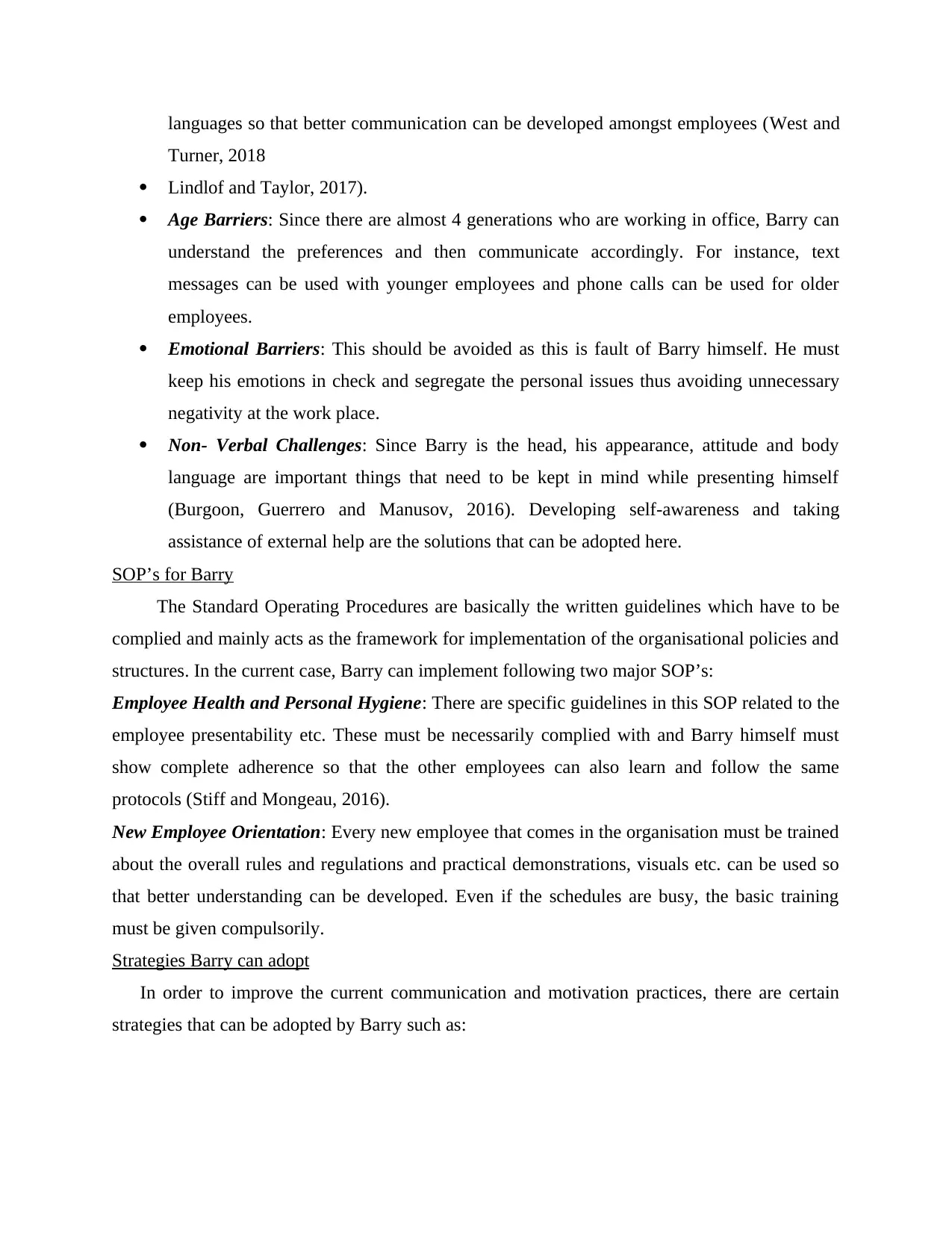
languages so that better communication can be developed amongst employees (West and
Turner, 2018
Lindlof and Taylor, 2017).
Age Barriers: Since there are almost 4 generations who are working in office, Barry can
understand the preferences and then communicate accordingly. For instance, text
messages can be used with younger employees and phone calls can be used for older
employees.
Emotional Barriers: This should be avoided as this is fault of Barry himself. He must
keep his emotions in check and segregate the personal issues thus avoiding unnecessary
negativity at the work place.
Non- Verbal Challenges: Since Barry is the head, his appearance, attitude and body
language are important things that need to be kept in mind while presenting himself
(Burgoon, Guerrero and Manusov, 2016). Developing self-awareness and taking
assistance of external help are the solutions that can be adopted here.
SOP’s for Barry
The Standard Operating Procedures are basically the written guidelines which have to be
complied and mainly acts as the framework for implementation of the organisational policies and
structures. In the current case, Barry can implement following two major SOP’s:
Employee Health and Personal Hygiene: There are specific guidelines in this SOP related to the
employee presentability etc. These must be necessarily complied with and Barry himself must
show complete adherence so that the other employees can also learn and follow the same
protocols (Stiff and Mongeau, 2016).
New Employee Orientation: Every new employee that comes in the organisation must be trained
about the overall rules and regulations and practical demonstrations, visuals etc. can be used so
that better understanding can be developed. Even if the schedules are busy, the basic training
must be given compulsorily.
Strategies Barry can adopt
In order to improve the current communication and motivation practices, there are certain
strategies that can be adopted by Barry such as:
Turner, 2018
Lindlof and Taylor, 2017).
Age Barriers: Since there are almost 4 generations who are working in office, Barry can
understand the preferences and then communicate accordingly. For instance, text
messages can be used with younger employees and phone calls can be used for older
employees.
Emotional Barriers: This should be avoided as this is fault of Barry himself. He must
keep his emotions in check and segregate the personal issues thus avoiding unnecessary
negativity at the work place.
Non- Verbal Challenges: Since Barry is the head, his appearance, attitude and body
language are important things that need to be kept in mind while presenting himself
(Burgoon, Guerrero and Manusov, 2016). Developing self-awareness and taking
assistance of external help are the solutions that can be adopted here.
SOP’s for Barry
The Standard Operating Procedures are basically the written guidelines which have to be
complied and mainly acts as the framework for implementation of the organisational policies and
structures. In the current case, Barry can implement following two major SOP’s:
Employee Health and Personal Hygiene: There are specific guidelines in this SOP related to the
employee presentability etc. These must be necessarily complied with and Barry himself must
show complete adherence so that the other employees can also learn and follow the same
protocols (Stiff and Mongeau, 2016).
New Employee Orientation: Every new employee that comes in the organisation must be trained
about the overall rules and regulations and practical demonstrations, visuals etc. can be used so
that better understanding can be developed. Even if the schedules are busy, the basic training
must be given compulsorily.
Strategies Barry can adopt
In order to improve the current communication and motivation practices, there are certain
strategies that can be adopted by Barry such as:
Paraphrase This Document
Need a fresh take? Get an instant paraphrase of this document with our AI Paraphraser
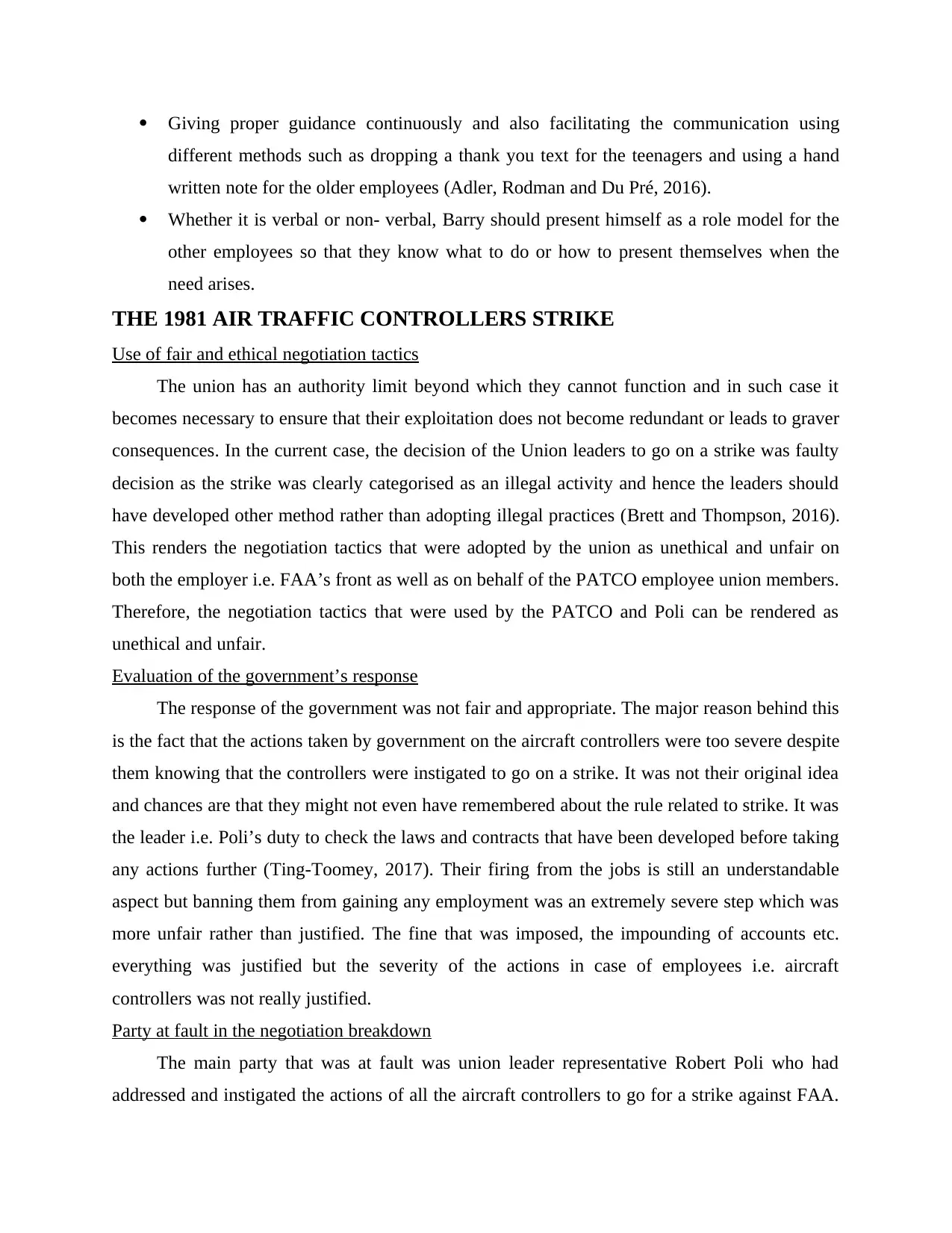
Giving proper guidance continuously and also facilitating the communication using
different methods such as dropping a thank you text for the teenagers and using a hand
written note for the older employees (Adler, Rodman and Du Pré, 2016).
Whether it is verbal or non- verbal, Barry should present himself as a role model for the
other employees so that they know what to do or how to present themselves when the
need arises.
THE 1981 AIR TRAFFIC CONTROLLERS STRIKE
Use of fair and ethical negotiation tactics
The union has an authority limit beyond which they cannot function and in such case it
becomes necessary to ensure that their exploitation does not become redundant or leads to graver
consequences. In the current case, the decision of the Union leaders to go on a strike was faulty
decision as the strike was clearly categorised as an illegal activity and hence the leaders should
have developed other method rather than adopting illegal practices (Brett and Thompson, 2016).
This renders the negotiation tactics that were adopted by the union as unethical and unfair on
both the employer i.e. FAA’s front as well as on behalf of the PATCO employee union members.
Therefore, the negotiation tactics that were used by the PATCO and Poli can be rendered as
unethical and unfair.
Evaluation of the government’s response
The response of the government was not fair and appropriate. The major reason behind this
is the fact that the actions taken by government on the aircraft controllers were too severe despite
them knowing that the controllers were instigated to go on a strike. It was not their original idea
and chances are that they might not even have remembered about the rule related to strike. It was
the leader i.e. Poli’s duty to check the laws and contracts that have been developed before taking
any actions further (Ting-Toomey, 2017). Their firing from the jobs is still an understandable
aspect but banning them from gaining any employment was an extremely severe step which was
more unfair rather than justified. The fine that was imposed, the impounding of accounts etc.
everything was justified but the severity of the actions in case of employees i.e. aircraft
controllers was not really justified.
Party at fault in the negotiation breakdown
The main party that was at fault was union leader representative Robert Poli who had
addressed and instigated the actions of all the aircraft controllers to go for a strike against FAA.
different methods such as dropping a thank you text for the teenagers and using a hand
written note for the older employees (Adler, Rodman and Du Pré, 2016).
Whether it is verbal or non- verbal, Barry should present himself as a role model for the
other employees so that they know what to do or how to present themselves when the
need arises.
THE 1981 AIR TRAFFIC CONTROLLERS STRIKE
Use of fair and ethical negotiation tactics
The union has an authority limit beyond which they cannot function and in such case it
becomes necessary to ensure that their exploitation does not become redundant or leads to graver
consequences. In the current case, the decision of the Union leaders to go on a strike was faulty
decision as the strike was clearly categorised as an illegal activity and hence the leaders should
have developed other method rather than adopting illegal practices (Brett and Thompson, 2016).
This renders the negotiation tactics that were adopted by the union as unethical and unfair on
both the employer i.e. FAA’s front as well as on behalf of the PATCO employee union members.
Therefore, the negotiation tactics that were used by the PATCO and Poli can be rendered as
unethical and unfair.
Evaluation of the government’s response
The response of the government was not fair and appropriate. The major reason behind this
is the fact that the actions taken by government on the aircraft controllers were too severe despite
them knowing that the controllers were instigated to go on a strike. It was not their original idea
and chances are that they might not even have remembered about the rule related to strike. It was
the leader i.e. Poli’s duty to check the laws and contracts that have been developed before taking
any actions further (Ting-Toomey, 2017). Their firing from the jobs is still an understandable
aspect but banning them from gaining any employment was an extremely severe step which was
more unfair rather than justified. The fine that was imposed, the impounding of accounts etc.
everything was justified but the severity of the actions in case of employees i.e. aircraft
controllers was not really justified.
Party at fault in the negotiation breakdown
The main party that was at fault was union leader representative Robert Poli who had
addressed and instigated the actions of all the aircraft controllers to go for a strike against FAA.
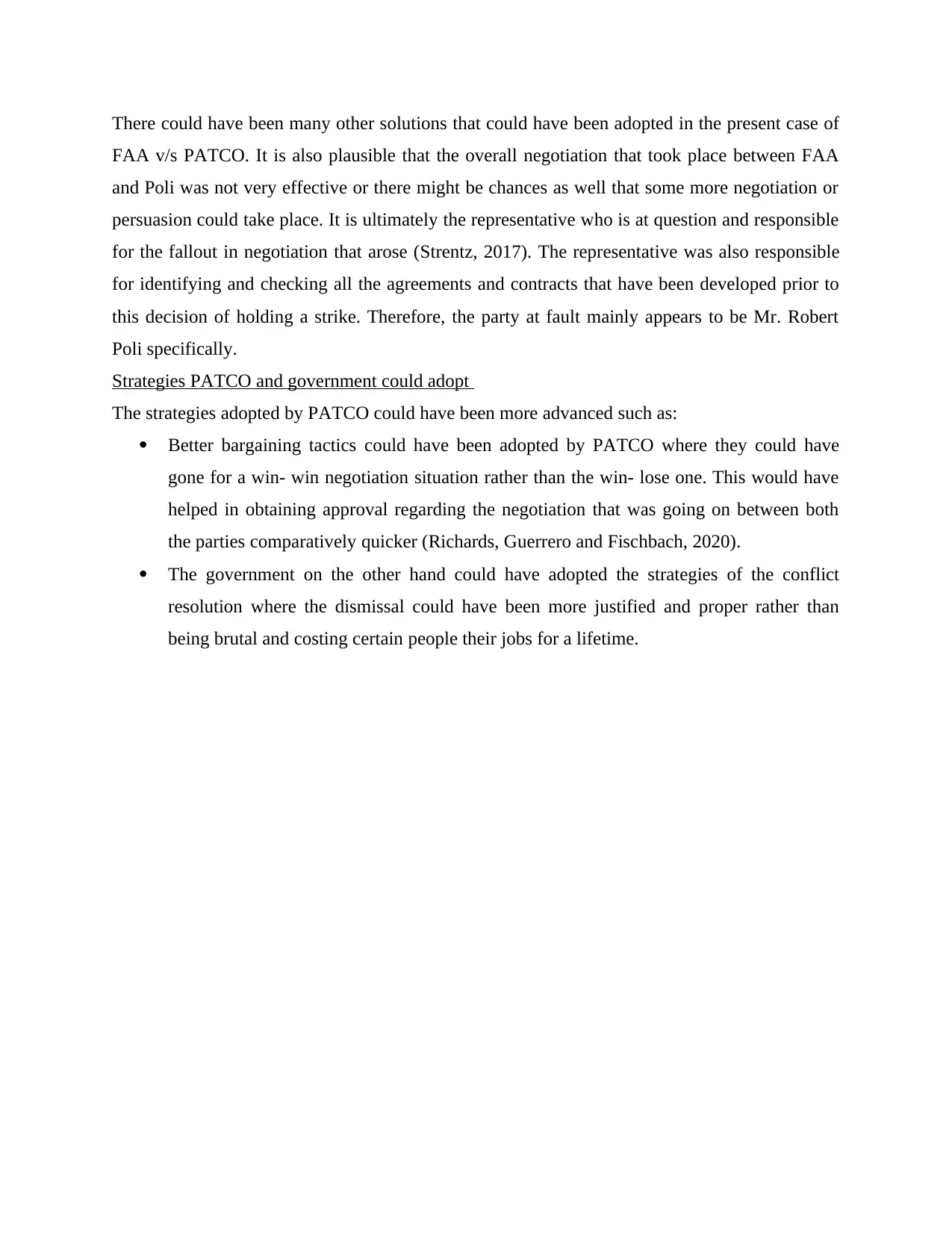
There could have been many other solutions that could have been adopted in the present case of
FAA v/s PATCO. It is also plausible that the overall negotiation that took place between FAA
and Poli was not very effective or there might be chances as well that some more negotiation or
persuasion could take place. It is ultimately the representative who is at question and responsible
for the fallout in negotiation that arose (Strentz, 2017). The representative was also responsible
for identifying and checking all the agreements and contracts that have been developed prior to
this decision of holding a strike. Therefore, the party at fault mainly appears to be Mr. Robert
Poli specifically.
Strategies PATCO and government could adopt
The strategies adopted by PATCO could have been more advanced such as:
Better bargaining tactics could have been adopted by PATCO where they could have
gone for a win- win negotiation situation rather than the win- lose one. This would have
helped in obtaining approval regarding the negotiation that was going on between both
the parties comparatively quicker (Richards, Guerrero and Fischbach, 2020).
The government on the other hand could have adopted the strategies of the conflict
resolution where the dismissal could have been more justified and proper rather than
being brutal and costing certain people their jobs for a lifetime.
FAA v/s PATCO. It is also plausible that the overall negotiation that took place between FAA
and Poli was not very effective or there might be chances as well that some more negotiation or
persuasion could take place. It is ultimately the representative who is at question and responsible
for the fallout in negotiation that arose (Strentz, 2017). The representative was also responsible
for identifying and checking all the agreements and contracts that have been developed prior to
this decision of holding a strike. Therefore, the party at fault mainly appears to be Mr. Robert
Poli specifically.
Strategies PATCO and government could adopt
The strategies adopted by PATCO could have been more advanced such as:
Better bargaining tactics could have been adopted by PATCO where they could have
gone for a win- win negotiation situation rather than the win- lose one. This would have
helped in obtaining approval regarding the negotiation that was going on between both
the parties comparatively quicker (Richards, Guerrero and Fischbach, 2020).
The government on the other hand could have adopted the strategies of the conflict
resolution where the dismissal could have been more justified and proper rather than
being brutal and costing certain people their jobs for a lifetime.
⊘ This is a preview!⊘
Do you want full access?
Subscribe today to unlock all pages.

Trusted by 1+ million students worldwide
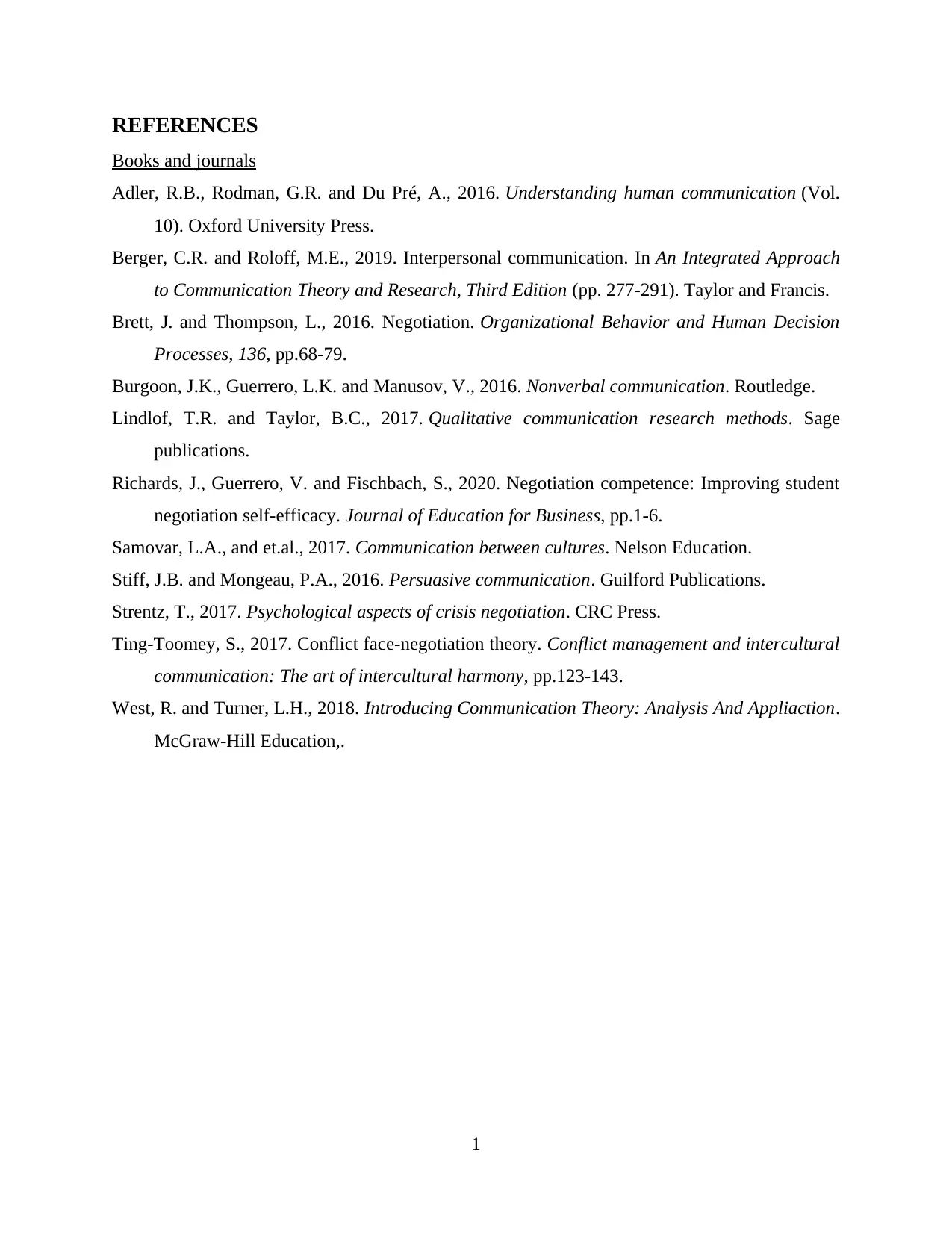
REFERENCES
Books and journals
Adler, R.B., Rodman, G.R. and Du Pré, A., 2016. Understanding human communication (Vol.
10). Oxford University Press.
Berger, C.R. and Roloff, M.E., 2019. Interpersonal communication. In An Integrated Approach
to Communication Theory and Research, Third Edition (pp. 277-291). Taylor and Francis.
Brett, J. and Thompson, L., 2016. Negotiation. Organizational Behavior and Human Decision
Processes, 136, pp.68-79.
Burgoon, J.K., Guerrero, L.K. and Manusov, V., 2016. Nonverbal communication. Routledge.
Lindlof, T.R. and Taylor, B.C., 2017. Qualitative communication research methods. Sage
publications.
Richards, J., Guerrero, V. and Fischbach, S., 2020. Negotiation competence: Improving student
negotiation self-efficacy. Journal of Education for Business, pp.1-6.
Samovar, L.A., and et.al., 2017. Communication between cultures. Nelson Education.
Stiff, J.B. and Mongeau, P.A., 2016. Persuasive communication. Guilford Publications.
Strentz, T., 2017. Psychological aspects of crisis negotiation. CRC Press.
Ting-Toomey, S., 2017. Conflict face-negotiation theory. Conflict management and intercultural
communication: The art of intercultural harmony, pp.123-143.
West, R. and Turner, L.H., 2018. Introducing Communication Theory: Analysis And Appliaction.
McGraw-Hill Education,.
1
Books and journals
Adler, R.B., Rodman, G.R. and Du Pré, A., 2016. Understanding human communication (Vol.
10). Oxford University Press.
Berger, C.R. and Roloff, M.E., 2019. Interpersonal communication. In An Integrated Approach
to Communication Theory and Research, Third Edition (pp. 277-291). Taylor and Francis.
Brett, J. and Thompson, L., 2016. Negotiation. Organizational Behavior and Human Decision
Processes, 136, pp.68-79.
Burgoon, J.K., Guerrero, L.K. and Manusov, V., 2016. Nonverbal communication. Routledge.
Lindlof, T.R. and Taylor, B.C., 2017. Qualitative communication research methods. Sage
publications.
Richards, J., Guerrero, V. and Fischbach, S., 2020. Negotiation competence: Improving student
negotiation self-efficacy. Journal of Education for Business, pp.1-6.
Samovar, L.A., and et.al., 2017. Communication between cultures. Nelson Education.
Stiff, J.B. and Mongeau, P.A., 2016. Persuasive communication. Guilford Publications.
Strentz, T., 2017. Psychological aspects of crisis negotiation. CRC Press.
Ting-Toomey, S., 2017. Conflict face-negotiation theory. Conflict management and intercultural
communication: The art of intercultural harmony, pp.123-143.
West, R. and Turner, L.H., 2018. Introducing Communication Theory: Analysis And Appliaction.
McGraw-Hill Education,.
1
Paraphrase This Document
Need a fresh take? Get an instant paraphrase of this document with our AI Paraphraser

2
1 out of 8
Related Documents
Your All-in-One AI-Powered Toolkit for Academic Success.
+13062052269
info@desklib.com
Available 24*7 on WhatsApp / Email
![[object Object]](/_next/static/media/star-bottom.7253800d.svg)
Unlock your academic potential
Copyright © 2020–2025 A2Z Services. All Rights Reserved. Developed and managed by ZUCOL.




